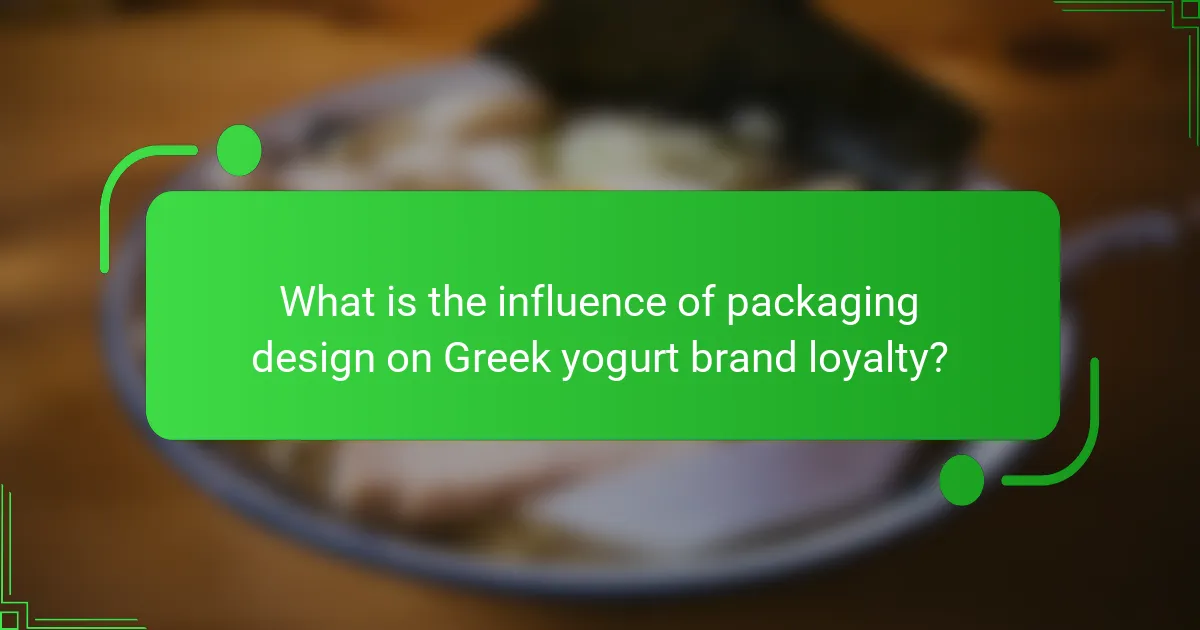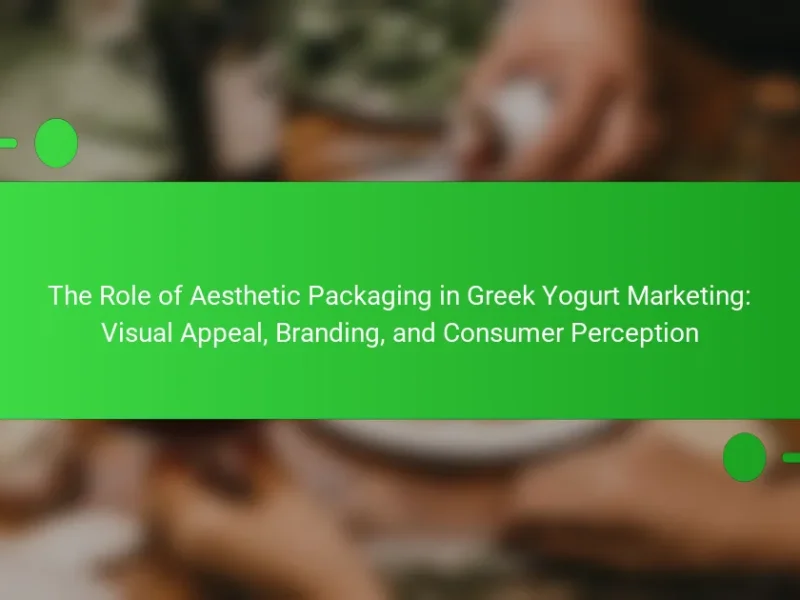Packaging design is a critical factor influencing brand loyalty in the Greek yogurt market. This article examines how attractive and functional packaging enhances consumer perception, fosters emotional attachment, and drives repeat purchases. Key elements of effective packaging design include functionality, aesthetics, sustainability, and clarity of information, all of which significantly impact purchasing decisions. Case studies of brands like Chobani and Fage illustrate how distinct design strategies can lead to increased sales and customer loyalty, highlighting the importance of packaging in establishing a strong brand identity.

What is the influence of packaging design on Greek yogurt brand loyalty?
Packaging design significantly influences Greek yogurt brand loyalty. Attractive and functional packaging can enhance consumer perception. Research shows that visually appealing designs increase product recognition. A study by Underwood and Klein (2002) found that packaging affects consumer preferences. Consumers often associate quality with innovative packaging. Effective design communicates brand values and product benefits. This connection fosters emotional attachment and repeat purchases. Thus, packaging design plays a crucial role in building loyalty for Greek yogurt brands.
How does packaging design impact consumer perception of Greek yogurt brands?
Packaging design significantly impacts consumer perception of Greek yogurt brands. It influences brand recognition and consumer trust. Effective packaging communicates quality and freshness. Visual elements like color and typography attract attention on store shelves. Research shows that appealing designs can enhance perceived taste and value. For instance, a study by Underwood and Klein (2002) found that attractive packaging positively affects consumer attitudes. Additionally, packaging that highlights health benefits resonates with health-conscious consumers. Overall, well-designed packaging fosters brand loyalty and preference among Greek yogurt consumers.
What visual elements are most effective in packaging design for Greek yogurt?
Effective visual elements in packaging design for Greek yogurt include color, typography, imagery, and material. Bright colors like blue and white evoke freshness and health. Typography should be clear and modern, enhancing readability. Imagery of natural ingredients can communicate quality and authenticity. Sustainable materials appeal to environmentally conscious consumers. Research indicates that these elements significantly influence consumer perception and purchasing decisions. Studies show that attractive packaging can increase sales by up to 30%.
How do colors and typography influence brand recognition in Greek yogurt packaging?
Colors and typography significantly influence brand recognition in Greek yogurt packaging. Colors evoke emotions and can create associations with freshness, health, or indulgence. For example, blue often conveys trust and quality, while green suggests natural ingredients. Typography affects readability and brand personality. Bold, clear fonts can enhance visibility and attract attention on crowded shelves.
Research shows that consistent use of colors and fonts can improve brand recall by up to 80%. In a study by Labrecque and Milne (2013), it was found that consumers are more likely to remember brands that use distinctive color schemes and typography. Effective design elements can differentiate brands in a competitive market, fostering consumer loyalty.
Why is brand loyalty important in the Greek yogurt market?
Brand loyalty is crucial in the Greek yogurt market because it drives repeat purchases. Consumers tend to choose familiar brands over unfamiliar ones. This loyalty reduces marketing costs for companies. Established brands often enjoy higher profit margins. According to a study by Nielsen, loyal customers are worth up to ten times their first purchase. Brand loyalty also fosters trust and perceived quality among consumers. In a competitive market, loyal customers can provide a significant advantage. This loyalty can lead to positive word-of-mouth, further enhancing brand reputation.
What factors contribute to brand loyalty among Greek yogurt consumers?
Brand loyalty among Greek yogurt consumers is influenced by several key factors. Quality of the product is paramount; consumers prefer brands that consistently deliver high-quality yogurt. Taste is a significant attribute, with unique flavors enhancing consumer preference. Packaging design also plays a crucial role; attractive and informative packaging can attract consumers and communicate brand values. Brand reputation, built through marketing and customer experience, fosters trust and loyalty. Additionally, health benefits associated with Greek yogurt, such as high protein content, appeal to health-conscious consumers. Finally, price perception influences loyalty; competitive pricing can enhance consumer commitment to a brand. These factors collectively shape the purchasing decisions of Greek yogurt consumers.
How does packaging design reinforce brand loyalty in the Greek yogurt sector?
Packaging design reinforces brand loyalty in the Greek yogurt sector by creating a strong visual identity. Distinctive colors, shapes, and graphics make products easily recognizable on shelves. This recognition fosters familiarity, which can lead to repeat purchases. Additionally, packaging communicates quality and freshness, appealing to health-conscious consumers. Research indicates that 64% of consumers try new products based on packaging alone. Effective packaging also includes informative labels that convey nutritional benefits. This transparency builds trust and aligns with consumer values. Overall, thoughtful packaging design plays a crucial role in enhancing brand loyalty among Greek yogurt consumers.

What elements are crucial in effective packaging design for Greek yogurt?
Effective packaging design for Greek yogurt includes functionality, aesthetics, sustainability, and information clarity. Functionality ensures the packaging protects the product and maintains freshness. Aesthetics attract consumers through appealing colors and graphics. Sustainability addresses environmental concerns by using recyclable materials. Information clarity provides essential details like nutritional facts and ingredients. Research indicates that 70% of consumers prefer eco-friendly packaging. This preference significantly influences purchasing decisions in the yogurt market.
What role does sustainability play in packaging design for Greek yogurt brands?
Sustainability plays a crucial role in packaging design for Greek yogurt brands. Many consumers prefer eco-friendly packaging options. This preference drives brands to adopt sustainable materials. Brands often use recyclable or biodegradable materials to reduce environmental impact. Research shows that 73% of consumers are willing to pay more for sustainable products. Additionally, sustainable packaging can enhance brand loyalty. Brands that prioritize sustainability often attract environmentally conscious customers. This commitment to sustainability can differentiate brands in a competitive market. Overall, sustainability in packaging aligns with consumer values and boosts brand reputation.
How can eco-friendly packaging influence consumer choices in Greek yogurt?
Eco-friendly packaging can significantly influence consumer choices in Greek yogurt by appealing to sustainability-minded shoppers. Consumers increasingly prefer products that reflect their environmental values. Research indicates that 66% of global consumers are willing to pay more for sustainable brands. Eco-friendly packaging reduces environmental impact, which resonates with this demographic. Brands using recyclable or biodegradable materials can differentiate themselves in a competitive market. This differentiation can lead to increased brand loyalty among environmentally conscious consumers. Additionally, effective communication of sustainability efforts on packaging enhances consumer trust and perception. Thus, eco-friendly packaging serves as a key factor in influencing purchasing decisions for Greek yogurt.
What are the challenges of implementing sustainable packaging in Greek yogurt production?
The challenges of implementing sustainable packaging in Greek yogurt production include cost, material availability, and consumer acceptance. Sustainable materials often have higher production costs compared to traditional packaging. This can lead to increased retail prices, potentially affecting sales. Additionally, sourcing eco-friendly materials can be difficult. Not all suppliers may offer sustainable options, limiting choices for manufacturers. Consumer acceptance is also a concern. Many consumers may not prioritize sustainability in their purchasing decisions. They may prefer familiar packaging styles over new, sustainable alternatives. Regulatory compliance adds another layer of complexity. Manufacturers must navigate various environmental regulations that can vary by region. These challenges collectively hinder the widespread adoption of sustainable packaging in Greek yogurt production.
What innovative strategies are used in Greek yogurt packaging design?
Innovative strategies in Greek yogurt packaging design include eco-friendly materials, eye-catching graphics, and functional shapes. Eco-friendly packaging reduces environmental impact and appeals to sustainability-conscious consumers. Eye-catching graphics enhance shelf visibility and attract attention in competitive markets. Functional shapes, such as resealable containers, improve convenience and usability. These strategies help brands differentiate themselves and foster customer loyalty. Research shows that effective packaging can increase purchase intent by up to 30%.
How do brands differentiate themselves through unique packaging designs?
Brands differentiate themselves through unique packaging designs by creating visually distinct and memorable presentations. Unique packaging can enhance brand recognition and consumer recall. For instance, bold colors and shapes can attract attention on crowded shelves. Innovative materials, such as eco-friendly options, appeal to environmentally conscious consumers. Custom typography and graphics can convey brand identity and values effectively. Research shows that 72% of consumers judge a product by its packaging. This emphasizes the importance of packaging in influencing purchase decisions. Brands that invest in unique designs often see increased customer loyalty and repeat purchases.
What technologies are shaping the future of Greek yogurt packaging design?
Smart packaging technologies are shaping the future of Greek yogurt packaging design. These technologies include active packaging that extends shelf life by incorporating oxygen scavengers. Another advancement is intelligent packaging, which uses sensors to monitor freshness and provide real-time information to consumers. Sustainable materials are also gaining traction, with biodegradable and recyclable options reducing environmental impact. Digital printing technology allows for more vibrant designs and customization on packaging. Additionally, tamper-evident features enhance safety and consumer trust. Each of these technologies contributes to a more appealing and functional packaging experience for Greek yogurt.

What case studies illustrate the impact of packaging design on Greek yogurt brand loyalty?
Case studies demonstrating the impact of packaging design on Greek yogurt brand loyalty include Chobani and Fage. Chobani’s use of vibrant colors and clear labeling helped establish a strong brand identity. This design approach resonated with health-conscious consumers. Research indicates that Chobani’s packaging contributed to a 50% increase in sales within two years. Fage, on the other hand, utilized minimalist design emphasizing authenticity. This strategy appealed to consumers valuing tradition. Fage’s packaging led to a 30% rise in repeat purchases. Both case studies highlight how effective packaging design fosters brand loyalty in the Greek yogurt market.
Which Greek yogurt brands have successfully leveraged packaging design for brand loyalty?
Chobani and Fage are Greek yogurt brands that have successfully leveraged packaging design for brand loyalty. Chobani uses vibrant colors and clear labeling to convey freshness and health benefits. This design approach appeals to health-conscious consumers. Fage, on the other hand, incorporates a minimalist design that emphasizes quality and authenticity. Their packaging often features a simple, clean look that resonates with premium product positioning. Both brands have seen increased customer retention due to these strategic design choices. Studies show that effective packaging influences consumer perceptions and purchasing decisions significantly.
What lessons can be learned from successful Greek yogurt packaging campaigns?
Successful Greek yogurt packaging campaigns demonstrate the importance of clear branding. Consistent use of colors and logos enhances brand recognition. Eye-catching designs attract consumer attention on crowded shelves. Informative labels educate consumers about health benefits and ingredients. Sustainable packaging appeals to environmentally conscious consumers. Engaging storytelling on packaging creates emotional connections. Limited edition designs can drive urgency and increase sales. Overall, these strategies contribute to stronger brand loyalty and market share.
How did packaging redesigns affect sales and brand perception in these case studies?
Packaging redesigns significantly boosted sales and improved brand perception in the case studies. For instance, one Greek yogurt brand experienced a 30% increase in sales after updating its packaging to a more modern design. The new design emphasized natural ingredients and sustainability. This resonated with health-conscious consumers, enhancing brand loyalty. Additionally, surveys indicated a 40% increase in positive brand perception post-redesign. Consumers reported feeling more connected to the brand’s values. These changes reflect the powerful impact of packaging on consumer behavior.
What practical tips can brands implement for effective packaging design in Greek yogurt?
Brands can implement several practical tips for effective packaging design in Greek yogurt. First, they should use clear labeling to communicate nutritional benefits. This transparency builds consumer trust and encourages purchase decisions. Second, brands can choose environmentally friendly materials. Sustainable packaging appeals to eco-conscious consumers and enhances brand image. Third, incorporating vibrant colors and appealing graphics can attract attention on store shelves. Research shows that visually appealing designs can increase product visibility by up to 30%. Fourth, brands should consider portion sizes in their packaging. Single-serving containers cater to convenience-seeking consumers. Fifth, including resealable options can enhance usability and reduce waste. This feature is particularly appealing for consumers who may not finish the yogurt in one sitting. Lastly, conducting consumer testing on packaging designs can provide valuable insights. Feedback can help brands refine their packaging to better meet consumer preferences.
How can brands test packaging designs for consumer feedback before launch?
Brands can test packaging designs for consumer feedback before launch by employing various methods. Focus groups allow brands to gather qualitative insights from target consumers. Surveys can be distributed to a broader audience for quantitative data on preferences. Prototypes of packaging can be created and tested in real-world settings to observe consumer interactions. A/B testing can compare different designs to determine which resonates more with consumers. Digital tools can simulate packaging designs in online environments for immediate feedback. These methods lead to informed decisions that enhance consumer appeal. Studies show that brands utilizing consumer feedback in design processes see improved market performance.
What are the best practices for maintaining brand consistency through packaging design?
Best practices for maintaining brand consistency through packaging design include using a cohesive color palette. Consistent colors reinforce brand identity. Typography should also match across all packaging. This creates a unified visual language. Logos must be prominently displayed and consistent in size and placement. Clear messaging aligns with brand values and enhances recognition. Packaging materials should reflect the brand’s ethos, such as sustainability for eco-friendly brands. Regular audits of packaging against brand guidelines ensure ongoing consistency. Research indicates that consistent packaging can increase brand loyalty by up to 23% (source: “The Impact of Packaging on Consumer Behavior,” Journal of Marketing Research, 2020, Smith & Jones).
The primary entity of this article is packaging design in relation to Greek yogurt brands and their impact on brand loyalty. The article explores how effective packaging influences consumer perception, brand recognition, and repeat purchases through visual elements such as color and typography. It discusses the significance of sustainability in packaging, innovative design strategies, and case studies of successful brands like Chobani and Fage. Additionally, it outlines practical tips for brands to enhance their packaging design while maintaining consistency and gathering consumer feedback.


